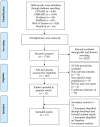Barriers, Enablers and Strategies for the Treatment and Control of Hypertension in Nepal: A Systematic Review
- PMID: 34708082
- PMCID: PMC8542767
- DOI: 10.3389/fcvm.2021.716080
Barriers, Enablers and Strategies for the Treatment and Control of Hypertension in Nepal: A Systematic Review
Abstract
Background: Understanding country-specific factors influencing hypertension care is critical to address the gaps in the management of hypertension. However, no systematic investigation of factors influencing hypertension treatment and control in Nepal is available. This study aimed to systematically review the published literature and synthesise the findings on barriers, enablers, and strategies for hypertension treatment and control in Nepal. Methods: Embase, PubMed, Web of Science, CINAHL, ProQuest and WorldCat, and Nepali journals and government websites were searched for qualitative, quantitative, and mixed-methods studies on factors or strategies related to hypertension treatment and control in Nepal. Information from qualitative studies was analysed using template analysis, while results from quantitative studies were narratively synthesised. Summary findings were framed under "health system", "provider", and "patient" domains. The protocol was registered in PROSPERO (registration number: CRD42020145823). Results: We identified 15 studies; ten related to barriers and enablers and five to strategies. The identified barriers associated with the health system were: lack of affordable services and lack of resources. The barriers at the provider's level were: communication gaps, inadequate counselling, long waiting hours for appointments, lack of national guidelines for hypertension treatment, and provider's unsupportive behaviours. Non-adherence to medication, irregular follow-up visits, lack of awareness on blood pressure target, poor help-seeking behaviours, reluctance to change behaviours, perceived side-effects of anti-hypertensive medication, self-medication, lack of family support, financial hardship, lack of awareness on blood pressure complications, and comorbidity were barriers identified at patient level. The following enablers were identified: free essential health care services, family support, positive illness perception, and drug reminders. Strategies implemented at the health system, provider and patient levels were: establishing digital health records at health centres, health worker's capacity development, and health education. Conclusion: There is a range of barriers for hypertension treatment and control in Nepal pertaining to the health system, health providers, and patients. Comprehensive interventions are needed at all three levels to further improve management and control of hypertension in Nepal.
Keywords: Nepal; barriers; control; facilitators; hypertension; treatment.
Copyright © 2021 Dhungana, Pedisic, Pandey, Shrestha and de Courten.
Conflict of interest statement
AP was employed by the company Abt Associates. The remaining authors declare that the research was conducted in the absence of any commercial or financial relationships that could be construed as a potential conflict of interest.
Figures
References
-
- World Health Organization . Political declaration of the High-level Meeting of the General Assembly on the Prevention and Control of Non-communicable Diseases New York: WHO; (2011). Available online at: https://www.who.int/nmh/events/un_ncd_summit2011/political_declaration_e....
-
- The World Bank Group . Population, total - Nepal (2020). Available online at: https://data.worldbank.org/indicator/SP.POP.TOTL?locations=NP.
Publication types
LinkOut - more resources
Full Text Sources



